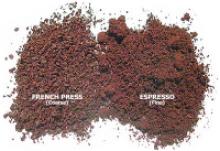For the true coffee fanatic, I was engaging in rank heresy. The blade grinder, isn't technically a grinder at all. The blades whir rapidly and crush the beans. This is considered anathema because the beans aren't all crushed evenly, and if you continue grinding or "pulsing" the grind becomes finer, which is not what you want for the average drip coffee maker. You want the grains to be equal in size because you want the water to be equally dispersed throughout the coffee during brewing.
The true fanatic therefore favors a burr grinder, wherein the "burrs" crush the beans between them. You can adjust the fineness of the grind by using a dial, which works by adjusting just how close the burrs are to each other, or a stationary surface. The ability to control the grind is crucial, because different brewing methods require different grinds of coffee. You want very coarse for a French press, medium coarse to medium for drip brewing or vacuum pots (you will note that there are gradations of medium depending on the kind of filter you use), and fine for espresso, and very fine for Turkish style coffee. There's a good chart with images showing you various grinds here.
There are two types of burr grinders; those that use a very rapidly spinning wheel, and those that use a conical burr. These are slower, quieter, and more expensive. They also are less likely to overheat and add a "burned" flavor or aroma to the coffee—a problem that some coffee drinkers have with blade grinders as well, since the longer you grind, the hotter the grinder gets. There are those who object to the mess of the burr grinder—they need to be cleaned fairly carefully with a brush, and static electricity can cause a fine powder to adhere to the top, and then spread all over your counter. And sometimes a fine sediment collects in the bottom of a cup, or a carafe, which leads some to argue that you should only use a burr grinder with a brewing system that uses paper filters.
Now, here's where my New England frugality kicks in; the average blade grinder is under twenty dollars. The most often recommended burr grinders are over $100.00. The coffee grinders I hear mentioned most often are the BARATZA Virtuoso Burr Coffee Grinder at just under $200.00, and the Capresso Infinity Burr Grinder, at around $140.00. That's a lot of coffee I won't be drinking. While I'm attracted to the notion of a manual box grinder from Zassenhaus, they're imported from Germany, and the company is having some problems, so while they are usually around $70.00 retail here, you can't find them currently. That means that I'm looking very closely at the Cuisinart DBM-8 Supreme Grind Automatic Burr Mill, which I'm seeing online for about $40.00.
